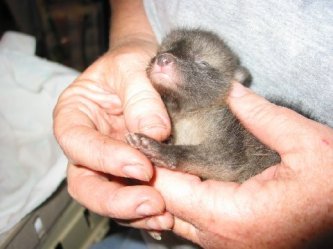The Red Fox (vulpes fulva)
The Gray Fox (urocuon ceneroargenteus)
The Arctic Fox (alopex lagopus)
The Kit Fox (vulpes velox)
There are four types of foxes in North America- the red, the gray, the arctic and the kit. Many of their characteristics are the same, but each has its own interesting differences. The fox is the smallest of the wild dogs of North America. It is one of the most intelligent of the wild animals and is very adaptable.
The most significant feature of a fox is its “brush” or tail, which is extremely important in cold weather. The fox will curl up tightly and cover the nose, paws and legs with the tail. The tail also plays a significant role in fox language to convey messages of dominance, submissiveness, aggression and playfulness. The tail is a third of the fox’s body length. Only the red fox has the white tip.
All foxes have oval- shaped eyes, which differs from the other members of the dog family, which have round eyes. The red fox has vertical pupils that can narrow to a slit, thus reducing the amount of bright sunlight. They also have a reflective membrane which causes the light to pass over the retina twice, greatly improving night vision.
The fox’s vibrissae (whiskers) are cat-like. They are longer than their wild dog cousins. A fox has a well developed sense of hearing. It can easily hear a mouse rustling under 2 feet of snow or grassy area.
Foxes are capable of leaping 15 feet or more.
 Foxes are quick learners and have been known to follow farmers mowers at haying time. They will snap up mice and voles injured or exposed by the haying process. Foxes are preeminent mousers without the aid of the farmer. They will also consume moles and voles. A fox’s wild diet includes grasshoppers, crickets, small birds, squirrels, rabbits, young woodchucks, snakes and lizards. They will occasionally take larger birds, such as pheasants and ducks. They also eat berries and fruit, such as grapes, apples and raspberries. They will eat about 1 pound of meat at a time. Red fox will bury or cache abundant prey in the summer and dig it up when food is scarce.
Foxes are quick learners and have been known to follow farmers mowers at haying time. They will snap up mice and voles injured or exposed by the haying process. Foxes are preeminent mousers without the aid of the farmer. They will also consume moles and voles. A fox’s wild diet includes grasshoppers, crickets, small birds, squirrels, rabbits, young woodchucks, snakes and lizards. They will occasionally take larger birds, such as pheasants and ducks. They also eat berries and fruit, such as grapes, apples and raspberries. They will eat about 1 pound of meat at a time. Red fox will bury or cache abundant prey in the summer and dig it up when food is scarce.
Foxes have numerous cries, calls and sounds. They do not howl like their wolf cousins. They do have a shrill alarm bark used to warn kits of danger when they are old enough to leave the den.
Foxes are sexually mature by the age of one. Late January is the typical mating season. The gray fox mating ritual is more aggressive than that of the red. Fox mating rituals involve an extended period of chasing that may last up to two weeks. During this time the fox will urinate a strong skunk-like odor. The male and female will separate for a time after mating. The vixen( female) will seek a den just before time for birthing.
A den site can often be detected by worn trails leading to it or by left over bones, feathers, etc. may be spotted. Red foxes prefer making their dens in an environment that allows easy digging. They will also enlarge an existing den of a woodchuck, skunk or another fox. Gray fox will use a ground den but prefer a hollow log or a hollow tree. The gray fox is not tidy about its den area, so you will more likely find bones from fish, birds or rabbits near the den site of the gray fox.
The dog fox ( male) will join the vixen to raise the kits. Kits are usually born in March or April. The typical litter size for all fox species will be 4 kits.
After the vixen gives birth, she will remain in the den for several days. The male will bring food to her during this time. The kit’s eyes do not open for ten days. At the age of 3 to 4 weeks, kits remain near the den opening. At 4 weeks, the kits will begin to fight each other. This is a means of establishing a dominance hierarchy, which determines which kit is fed first by the parents. If food becomes scarce, the dominant kits may be the only ones to survive. Fox kits are vulnerable to a number of predators including eagles, hawks, owls, coyotes and man. At approximately 8 weeks of age, the vixen will force the kits to stop nursing. Around the age of nine weeks,in early fall, young fox are able to feed themselves. They will begin to disperse in the fall after 10 weeks of age.
Foxes are highly territorial. The resident dog fox or vixen will savagely attack an intruder.
The average life span of a wild fox is 5 years. An adult fox’s small size makes it prey for wild cats, coyotes and wolves. Foxes are also affected by rabies, distemper and mange.
The Red Fox is found in every state with the exception of Florida. It is found across Canada to the arctic tundra. It can be found in mountains, forests and farmlands.
Legends about the red fox are many. Some American Indians considered the clever red fox the devil on earth.
The red fox is one of nature’s loveliest and most elegant creatures. The scientific name “vulpes” is the Latin word for fox. The classification “fulva” is from the Latin meaning of reddish- yellowish. It is sometimes called the cat-like fox.
Red fox fossils in North America have been dated back to sometime before the arrival of Columbus.
The red fox stands about 15 inches at the shoulder and weighs between 8 and 14 pounds. Red foxes are not always red. The “silver fox” is the black phase of the red and the “cross fox” is a red fox with dark fur in the shape of a cross down the back and across the shoulders.
Red foxes are stealth hunters. Both the red and gray fox will hunt during the day if they feel secure and have ample hiding places. Reds hunt in the same manner as a small cat. When possible, they will stalk their prey and either pounce on it or run it down with a quick burst of speed. Red foxes are solitary hunters. The red can partially retract its claws, which permits it to stalk quietly, helps the claws stay sharper ,which aids in pinning the prey. Red foxes will prey on anything they can catch and kill.
If chased, a red fox will leap a distance or travel down a stream to put distance between its foot track. They are capable of running 30 miles per hour for several miles, leap obstacles up to six feet in height and easily swim across rivers and streams.
The Gray Fox has a similar range to the red. Its genus name is”urocyon cineroargenteus”. The gray fox tends to avoid areas that have very cold weather. It will inhabit areas of habitat that the red fox avoids. It prefers wooded areas and is not found in the plains states or the western mountain states of the U.S. Sometimes called the “tree fox”, the gray fox will climb up a leaning tree to take a nap in the lower branches. Grays have been seen eating eggs or young nestlings out of their nests. Gray foxes will also climb a tree to escape predators. They will climb on to a leafy branch and flatten themselves to avoid detection. The gray fox is less likely to live near humans. It is also less likely to be seen, as it prefers to move about at night.
The fur of a gray fox is usually a silvery gray but may have also have markings of black, orange and white. The underside will usually be white or light gray. The gray’s tail will be tipped in gray or black. The gray fox weighs less than the red but its body is longer. They typically stand 15 inches at the shoulder and will weigh between 7 and 11 pounds.
The gray fox is the best fighter in the fox clan. A gray fox will stand up to a single dog and easily drive it away.
The Kit Fox (vulpes velox) is the smallest of the North American foxes. It is found in the desert and plains areas of the United States. Its range in the U.S. is limited. It prefers dry, brushy areas. It is sometimes called the “swift fox” due to its habit of darting after things and the speed at which it does this.
The kit fox’s fur is yellowish gray with light colored underbelly. The tail is tipped in black. The adult weight ranges between 4 and 6 pounds and it stands 12 inches at the shoulder. The kit fox family life differs from his cousins as the off-spring remain with the parents for one year before dispersing on their own.
The kit fox prefers a nocturnal life. It spends the day in a burrow and always digs a second entrance for escape. Most foxes will run if surprised, but the kit fox will freeze and lay close to the ground.
A kit fox’s diet will include ground squirrels, prairie dogs, rabbits, snakes, lizards, small birds and insects. It will eat grass and berries if meat is not available.
The kit fox has the longest ears of the foxes and its vocalizations are more like the “chatter” of squirrels than the yelping and yapping of the other fox clan members. The kit fox does not tolerate human presence and requires a desert habitat to survive.
The Arctic Fox (alopex lagopus) looks least like its cousins. It has a shorter nose, short rounded ears, stands less than 12 inches at the shoulder and is the heaviest of the foxes, weighing in at 15 pounds.
Another unusual trait is that it changes its fur color with the seasons. Summer will find it in the brown phase and white during the winter.
It tolerates people more than the other species and will follow hunters and trappers in hopes of an easy meal. Winter feeding for the arctic fox is usually leftovers from a larger animal’s kill or a whale that has beached itself. In summer, its diet includes lemmings and other rodents, ptarmigan, as well as other bird’s eggs.
Their fur is the softest in the fox family. Young are raised in hillside dens in spring in a similar fashion to its fox cousins. By fall, as with other foxes, the young are able to care for themselves.(reprinted with permission from Wild at Heart)
